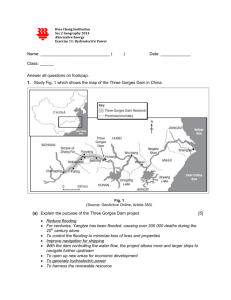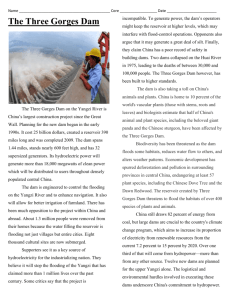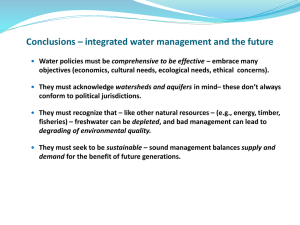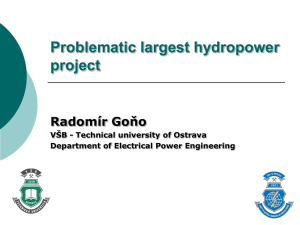3 Gorges Dam
advertisement
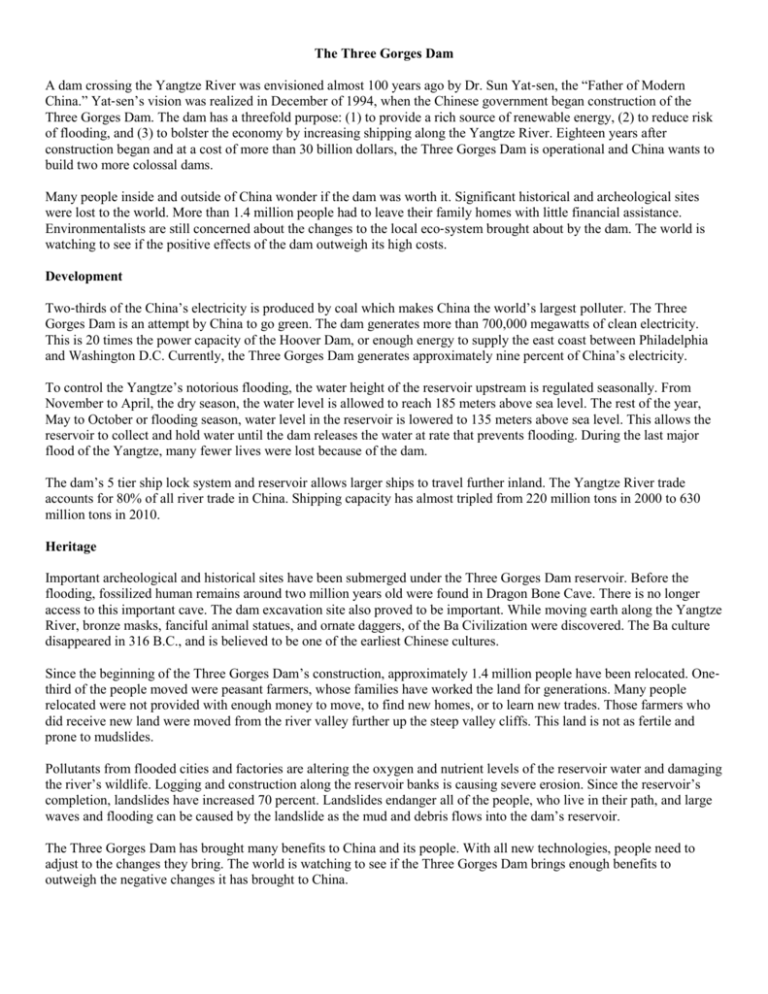
The Three Gorges Dam A dam crossing the Yangtze River was envisioned almost 100 years ago by Dr. Sun Yat‐sen, the “Father of Modern China.” Yat‐sen’s vision was realized in December of 1994, when the Chinese government began construction of the Three Gorges Dam. The dam has a threefold purpose: (1) to provide a rich source of renewable energy, (2) to reduce risk of flooding, and (3) to bolster the economy by increasing shipping along the Yangtze River. Eighteen years after construction began and at a cost of more than 30 billion dollars, the Three Gorges Dam is operational and China wants to build two more colossal dams. Many people inside and outside of China wonder if the dam was worth it. Significant historical and archeological sites were lost to the world. More than 1.4 million people had to leave their family homes with little financial assistance. Environmentalists are still concerned about the changes to the local eco‐system brought about by the dam. The world is watching to see if the positive effects of the dam outweigh its high costs. Development Two‐thirds of the China’s electricity is produced by coal which makes China the world’s largest polluter. The Three Gorges Dam is an attempt by China to go green. The dam generates more than 700,000 megawatts of clean electricity. This is 20 times the power capacity of the Hoover Dam, or enough energy to supply the east coast between Philadelphia and Washington D.C. Currently, the Three Gorges Dam generates approximately nine percent of China’s electricity. To control the Yangtze’s notorious flooding, the water height of the reservoir upstream is regulated seasonally. From November to April, the dry season, the water level is allowed to reach 185 meters above sea level. The rest of the year, May to October or flooding season, water level in the reservoir is lowered to 135 meters above sea level. This allows the reservoir to collect and hold water until the dam releases the water at rate that prevents flooding. During the last major flood of the Yangtze, many fewer lives were lost because of the dam. The dam’s 5 tier ship lock system and reservoir allows larger ships to travel further inland. The Yangtze River trade accounts for 80% of all river trade in China. Shipping capacity has almost tripled from 220 million tons in 2000 to 630 million tons in 2010. Heritage Important archeological and historical sites have been submerged under the Three Gorges Dam reservoir. Before the flooding, fossilized human remains around two million years old were found in Dragon Bone Cave. There is no longer access to this important cave. The dam excavation site also proved to be important. While moving earth along the Yangtze River, bronze masks, fanciful animal statues, and ornate daggers, of the Ba Civilization were discovered. The Ba culture disappeared in 316 B.C., and is believed to be one of the earliest Chinese cultures. Since the beginning of the Three Gorges Dam’s construction, approximately 1.4 million people have been relocated. One‐ third of the people moved were peasant farmers, whose families have worked the land for generations. Many people relocated were not provided with enough money to move, to find new homes, or to learn new trades. Those farmers who did receive new land were moved from the river valley further up the steep valley cliffs. This land is not as fertile and prone to mudslides. Pollutants from flooded cities and factories are altering the oxygen and nutrient levels of the reservoir water and damaging the river’s wildlife. Logging and construction along the reservoir banks is causing severe erosion. Since the reservoir’s completion, landslides have increased 70 percent. Landslides endanger all of the people, who live in their path, and large waves and flooding can be caused by the landslide as the mud and debris flows into the dam’s reservoir. The Three Gorges Dam has brought many benefits to China and its people. With all new technologies, people need to adjust to the changes they bring. The world is watching to see if the Three Gorges Dam brings enough benefits to outweigh the negative changes it has brought to China. A Cruise on the Yangtze River Jordan kept a journal of his trip to china in 2012. He and his family first visited China in 2000. On both trips, they took a cruise through the Three Gorges, considered one of the natural wonders of China. July 8: We were finally on board! In a few hours we would embark on our journey to the beautiful Three Gorges, the birthplace of Chinese civilization. We visited here once before when I was five. My parents told me that some things might be different this year because the Three Gorges Dam has been completed. The Yangtze River upstream, behind the dam, is both higher and wider. July 9: Today we arrived at our first stop, the historic Shibaozhai Temple, built over 400 years ago. This wooden pagoda, rising 12 stories high, stands at a height of 183 feet. My parents said that people were worried that parts of the temple would be damaged by the rising river waters and reservoir caused by the Three Gorges Dam. The Chinese government surrounded the temple with 22 steel and concrete pillars connected with a wall that turned the temple into a miniature island in a man‐made lake! Our guide told us that the government spent 125 million dollars to save ancient treasures such as primitive campsites, tombs, and old temples. July 10: As we cruised through the Qutang Gorge, the first of the three gorges, our ship was dwarfed by its majestic cliffs looming above us. My father says that since the water is higher, the height of the mountains is not as dramatic as it once was. My mother remarked that there seemed to be many more boats in the gorge than there were ten years ago. A crew member explained that this is because the increased water from the Three Gorges Dam has widened the river and allowed more ships to enter the gorges. At the entrance to the gorge is the Chalk Wall. Almost 1,000 characters were carved into the sides of the gorge, some more than 700 years ago. Mom explained that the last time we were here we could see all of the characters, now parts of them were below the river’s water line. The cruise director explained that some of the characters had been cut out of the gorge and put in museums to protect them from the water. Next, we drifted through the eerily beautiful Wu Gorge, as the fog swirled around the unusual rock formations which form the famous 12 unique peaks. My favorite was Goddess Peak. Legend has it that twelve fairy sister came to help stop the terrible flooding and got trapped in the mountains. Flooding has caused many problems for people living on the Yangtze. It destroys their homes and crops. Our guide said that China hopes the Three Gorges Dam will help control the flooding. As we entered the Xiling Gorge, the last of the gorges, we disembarked and got into another boat. The rowers sang traditional songs as we gazed at the amazing scenery. Once we returned to the ship, we zigzagged through the long, narrow passage of the Xiling Gorge where we saw the caves and scenery that famous poets like Qu Yuan wrote about. The Three Gorges Dam is built in this gorge. July 11: Our tour guide gave us a tour of the Three Gorges Dam today, which she described as the Great Wall of the Yangtze. The immense dam towers 610 feet high and spans a distance of 1.3 miles. In the process, over one million people were relocated to new cities built by the government because their own cities and towns were covered by water. Built both to decrease flooding and provide a source of renewable energy, the dam produces as much energy as 18 nuclear power plants. This was an amazing trip! I collected so many wonderful memories of this marvelous natural wonder. When I have children of my own, I will return to the Three Gorges. I wonder how things will have changed. Grade 8 Argumentative Writing Task Prompt China finished construction of the Three Gorges Dam on July 4, 2012. This dam is the largest hydroelectric dam in the world. China now has plans to build four more hydroelectric dams along the Jinsa River, a river that flows into the Yangtze River. Write an argument whether China should build more large hydroelectric dams. Be sure to state a claim and counter claim and use evidence from both passages. Before you begin planning and writing your argument, read 1. “A Brief History of the Three Gorges Dam” 2. “ A Cruise Down the Yangtze River” Use the space below and the back of this paper to plan for your essay.

